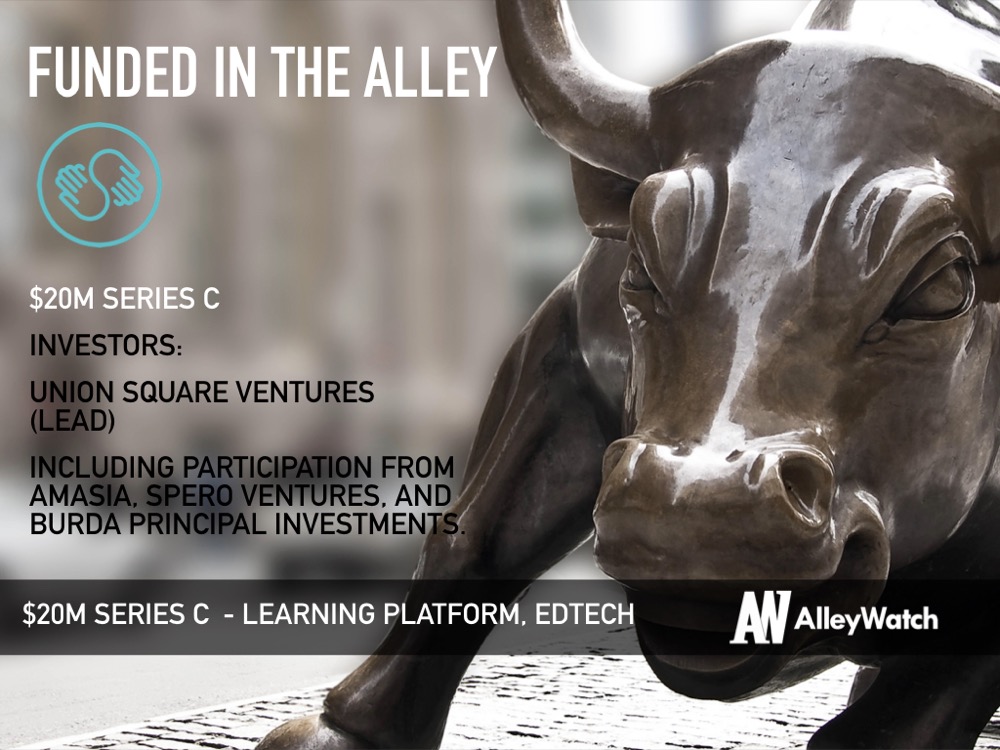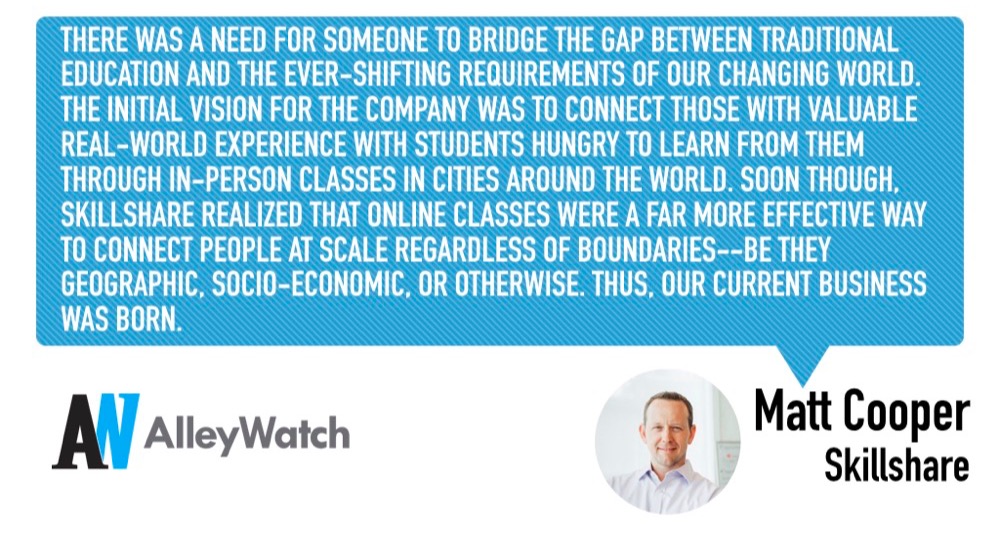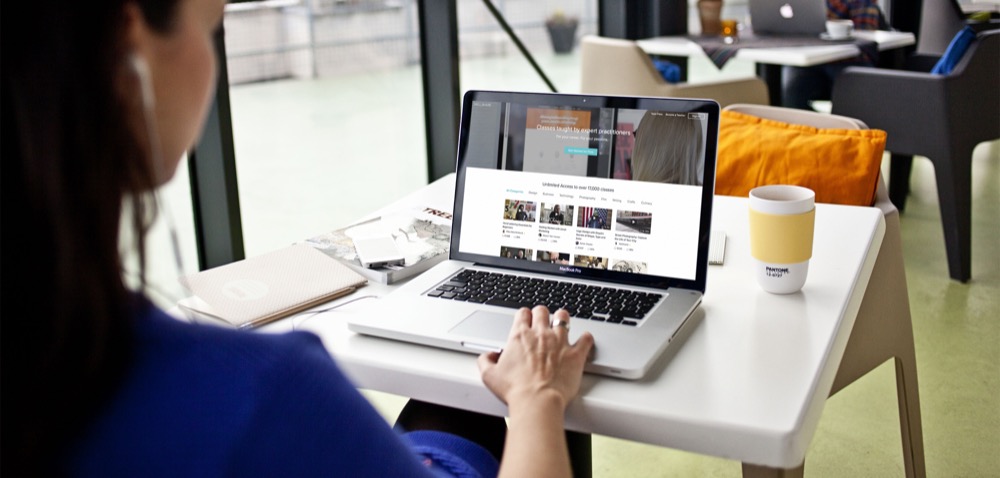Learning is a lifelong process and Skillshare is the online learning community that offers hundreds of classes that teach real-world creative and entrepreneurial skills. This self-proclaimed hub for curious individuals differentiates itself from other online learning communities through its open platform and subscription program. This e-learning startup has a strong following amongst the ever-growing freelance community, by 2020 experts predict that the freelance economy alone will make up around 50% of the U.S. workforce.
AlleyWatch spoke with CEO Matt Cooper about its latest round of funding for the startup founded in 2010.
Who were your investors and how much did you raise?
Our latest round was a Series C and the equity portion totaled $20M, as well as an additional $8M in venture debt.
Previous investor Union Square Ventures led the round. Amasia and Spero Ventures (also existing investors) were joined by Burda Principal Investments, the investment arm of one of Germany’s largest media and tech companies as additional participants to the round.
Tell us about the product or service that Skillshare offers.
Skillshare is an online learning community with thousands of online classes in real-world creative and entrepreneurial skills. Anyone can take classes, connect with others, and even teach a class themselves.
Basic membership is free and includes access to a selection of hundreds of classes. Members can then upgrade to Premium for a low, monthly rate to gain access to the full class catalog. Today, Skillshare teachers include both industry leaders (like author and speaker Simon Sinek and notable designer Aaron Draplin) and talented practitioners who have built a following and significant passive income stream through the site.
What inspired you to start Skillshare?
There was a need for someone to bridge the gap between traditional education and the ever-shifting requirements of our changing world. The initial vision for the company was to connect those with valuable real-world experience with students hungry to learn from them through in-person classes in cities around the world. Soon though, Skillshare realized that online classes were a far more effective way to connect people at scale regardless of boundaries–be they geographic, socio-economic, or otherwise. Thus, our current business was born.
Since then, Skillshare has become a hub where curious individuals, often with a strong streak of creativity running through them, come to learn from those that have come before them, find inspiration and network with kindred spirits.
How is Skillshare different?
Functionally, Skillshare is different from other online class platforms in that we’re the only one who is both a subscription and an open platform. What this means for our members is that they have access to a huge breadth of classes that they can explore and try at no incremental cost.
More importantly, though, Skillshare is different from other platforms in how we philosophically approach learning overall. The vast majority of other providers really view education or learning as a transaction that should be completed as quickly as possible: take this class or boot camp, learn this skill, and get on with your life.
Skillshare views learning differently. We’re curious. We think learning is something that should never stop–and we’ve built our offering for people who share that belief. So, yes, on Skillshare you can still take a class on the latest and greatest skill in your specific field, but you can also explore new things and discover new insights and connect with other curious individuals. And through that exploration and discovery and connecting, we believe people become more versatile, more innovative and better at everything they do.
What market does Skillshare target and how big is it?
Our core market is a group we call “The Independent Class.” This group is comprised of the fast-growing freelance workforce as well as entrepreneurs and other independent-minded individuals who crave autonomy and meaning in their work. In aggregate, this group represents a huge proportion of the population. It’s predicted that the freelance economy alone will make up around 50% of the U.S. workforce by 2020–and you see similar trends in many international markets.
Skillshare is both a subscription business and a platform business. We’re subscription in the sense that our premium members pay a low, monthly fee for unlimited access to our catalog of 20k+ classes. We’re a platform business in that the majority of our supply of classes comes from our open platform and we act as the connecting mechanism between those with expertise to share and those who want to learn from that expertise.
How does your role as CEO change as the company continues to scale? What will you focus on and what will you be doing less of?
As a company grows, you get further away from the day-to-day execution and just can’t physically stay on top of everything going on. At that point, you need to make sure that you have the right team working on the right things for the right reasons. I still like to get my hands dirty, but I need to focus on three things: 1) making sure we have strong team and amazing management, 2) setting the right context for our business, competition, and strategy, and 3) driving alignment on where we’re going and how we’re going to get there. Then I get out of my team’s way and let them show how good they are.
What was the funding process like?
I always find fundraising to be long and painful :-). Joking aside, the great side effect of fundraising is you really get to know your business. Clear themes emerge from the questions you are asked, where you get pushback, why firms decline to move forward. There’s no doubt we know the strengths and weaknesses of our business much better today than we did before we started the raise. I’m also as confident as ever in why we can make a big dent in a massive market.
What are the biggest challenges that you faced while raising capital?
We started raising at a pretty significant inflection point in our growth. All the numbers were looking up and to the right, but we had months of that trajectory and not years. We were also in a ‘tweener’ stage — a little too big for venture, but a little too small for a growth/private equity round. As time went on, our core metrics just kept getting better and it was easier to show the power of our business model.
What factors about your business led your investors to write the check?
The three biggest factors were probably:
- Our huge potential market of the independent class and ambitious vision to tap into that market.
- Our financial performance, including revenue growth (100%+ year-over-year growth) and overall capital efficiency, given our subscription model.
- The great team we’ve built over the last eighteen months and how well they understand the levers of our business.
What are the milestones you plan to achieve in the next six months?
We have some specific goals for the remainder of the year, but the more interesting goal is we are targeting 1 million paying members by 2020. It’s aggressive and a lot of things will need to go right to pull it off, but I think we have the team, the product, and the market to make it happen.
What advice can you offer companies in New York that do not have a fresh injection of capital in the bank?
First of all, focus on your unit economics. If you can show that the business can grow efficiently and create real value at the customer level, it will make fundraising that much easier. Second, fundraising always takes longer than you expect. Give yourself plenty of time and have a backup plan to get to cash flow positive should funding not be available.
Where do you see the company going now over the near term?
We are keeping the gas pedal down on growth. We have a lot of momentum right now, so we want to keep that going while starting to make some bets that will drive our growth 18-24 months out. We’re going to be investing more to support our international users (which account for almost half of all new users today), focusing on features that strengthen the community aspects of Skillshare, and continuing to bring great teachers and classes onto the platform.
What’s your favorite restaurant in the city?
Our last office was in Nolita, about 300 yards from Prince Street Pizza. The first step is admitting you have a problem. We had to move the office to Flatiron.






